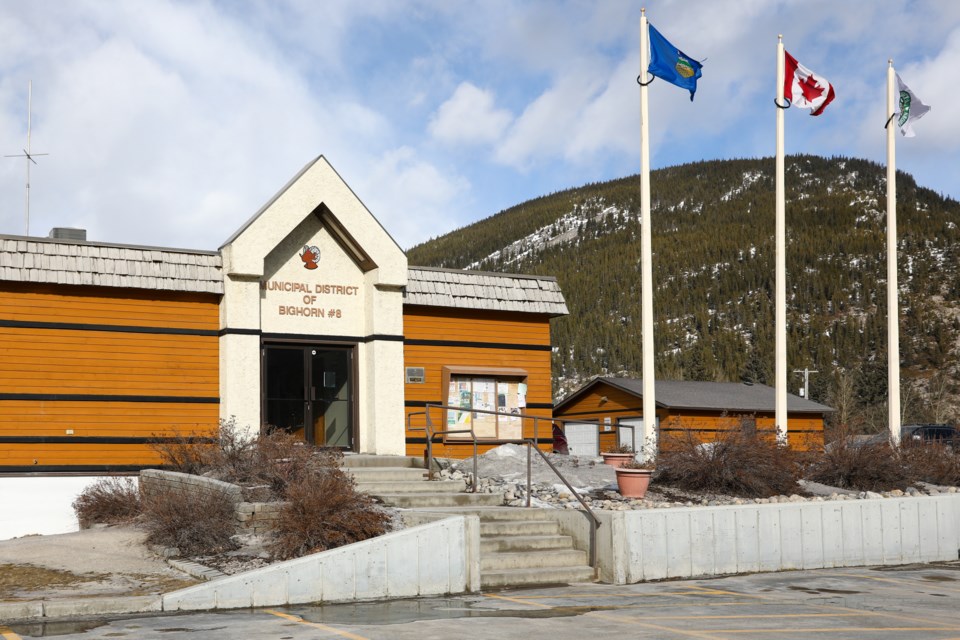MD OF BIGHORN – The MD of Bighorn is reviewing a bylaw that would allow it to go $10 million in the red covering the costs of a long-awaited operations building.
The $11.4 million building is planned on newly acquired lands swapped with the province near Dead Man’s Flats. The lengthy land exchange process, which lasted nearly two decades and was finalized in July, saw construction costs for the project surge to nearly double what was previously budgeted.
Constructing a new operations building has been discussed by former councils of the last decade. In the municipality’s 2020-25 capital plan, the operations shop was to be replaced in 2022 for $6.2 million.
“The costs of the overall project have increased significantly from when we initially started to plan for it,” said MD of Bighorn CAO Shaina Tutt.
“[The land swap] is now completed, so we are able to start finalizing these plans and likely locking in on prices rather than continuing to watch costs escalate while we wait for land to build the shop on.”
The borrowing bylaw proposes construction of the operations building would be funded through a 30-year Federation of Canadian Municipalities (FCM) loan of $7.752 million with an interest rate not to exceed 5.5 per cent per annum, and a 25-year loan of $2.280 million from the Royal Bank of Canada, not to exceed an interest rate of 7.5 per cent per annum.
Combined annual payments for the 30- and 25-year debts would amount to $721,560 and begin in 2025.
If received, the rest of the funding would come from a $1.368 million competitive grant from the FCM.
Coun. Rick Tuza noted previous councils budgeted for the project and asked why those funds weren’t suggested to decrease the loan requirement. The MD currently has about $18 million in reserves.
“I understand there may be a benefit to asking for certain amounts of money and holding onto that money and using that money to pay off yearly … I’d just like to hear it so that the public can kind of understand that concept,” he said.
“There’s going to be people saying ‘hey, we have money set aside for this building, what happened to it’”?
Brenda Hewko, director of corporate and community services with the MD, noted the municipality currently has about $800,000 in debt with a debt capacity of up to $16 million, as determined by the Municipal Government Act.
Hewko said borrowing money for the project is a good use of debt because the use of the asset – the operations building – outlasts the debt term, and there is also flexibility to fund from reserves and pay off loans early.
“If we decide in a few months that we do want X per cent, we can use restricted surplus and just take less debt on,” said Hewko, noting the bank loan portion offers some adjustability.
By having the bylaw in place, she noted it allows the MD the flexibility to borrow, as well as fund from grants and reserves.
Tutt assured the funds set aside for the project by previous councils are still in reserves to be used at the discretion of council.
She also suggested it was in the MD’s best interest to apply for the loans rather than depleting reserves and allowing the project to move ahead as planned.
In 2021, building a new operations building was identified as the main priority in a trio of projects planned by the MD, including a new fire hall and administration building.
Council approved the hiring of Calgary-based MTA Urban Design, Architecture, Interior Design Inc. to help identify future sites for the municipal buildings. At that time, MTA determined the current operations shop was in “bad shape” and recommended a new operations shop be built on the land being swapped with the province.
In a previous interview with the Outlook, Rosvold said the new shop is desperately needed. The current building is a Quonset, moved to Exshaw from the 1988 Olympics in Calgary.
“It has been overflowing for – I hate to say it – but I think decades,” she said. “We’ve known for a number of years that we would be getting one of these parcels of land from the land swap, so we’ve been reluctant to move forward and build a new shop somewhere else because that land is the most ideal location for it.”
In the exchange, the MD received 26.7 hectares, split into three parcels ideal for industrial and commercial development east of Exshaw. In return, the province received 8.9 hectares of vital wildlife habitat split between a section north of the G8 Legacy wildlife underpass on the Trans-Canada Highway near Dead Man’s Flats and land north of the hamlet adjacent to the Bow River. No money changed hands in the swap.
The MD has also been eyeing its newly acquired lands for a future fire hall and administration building. The municipality’s 2024 draft budget proposes $100,000 be withdrawn from reserves to explore the feasibility of a fire station in Dead Man’s Flats. The draft budget includes another $3 million coming out of reserves for a fire hall between 2026 and 2027, but there are no other immediate plans for those projects.
The borrowing bylaw for the operations building was first brought forward at the Sept. 26 governance and priorities committee meeting and passed first reading of council Oct. 10. The bylaw was subsequently advertised to the public by the MD and is expected to return for potential second reading of council in December.
The Local Journalism Initiative is funded by the Government of Canada. The position covers Îyârhe (Stoney) Nakoda First Nation and Kananaskis Country.




